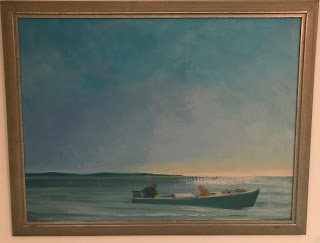Francis Quirk was an Ossabaw Island Fellow and spoke fondly about the institution with Pennsylvania friends. We believe he may have also capitalized on his time in Georgia to reach out to patrons and obtain other commissions. Note that he has a portrait in the Georgia Museum of Art. We also believe he may have visited the region on multiple occasions.
Many were painted while spending time at the Ossabaw Island Foundation.
Ossabaw Island is a national treasure preserved by Eleanor Torrey-West and her family for the benefit of present and future generations. Ossabaw is a 26,000 acre undeveloped barrier island on the Atlantic Ocean owned by the State of Georgia and located in Chatham County and not too far from Savannah. The island was generously transferred to the State of Georgia on June 15,1978 and designated as Georgia’s first Heritage Preserve with the written understanding that Ossabaw would “only be used for natural, scientific and cultural study, research and education, and environmentally sound preservation, conservation and management of the Island’s ecosystem.” The acquisition was made possible by the generosity of Mrs. West and her family, a personal gift to the State of Georgia from Robert W. Woodruff, the assistance of The Nature Conservancy, and the State’s commitment to preservation of the island.
 |
| Ossabaw Island on Georgia's Coast |
The Ossabaw Island Foundation is a public non-profit 501 c3. Through a public-private partnership with the State of Georgia, inspires, promotes, and manages exceptional educational, cultural, and scientific programs that are designed to maximize the experience of Ossabaw Island, while minimizing the impact on its resources.
The Foundation welcomes all creative people including writers to come and work on the island and be inspired by Ossabaw's solitude and beauty.
In order to continue to balance their operating budget they are no longer able to support complimentary stays.
We have been able to find images of several works painted at the Island.
Glossy White Faced Iris- This painting was featured on the pamphlet for Quirk's solo show at Lehigh in 1973. The pamphlet only showed this black and white image.
 |
| Black and White Image of Glossy White Faced Ibis by Francis J. Quirk oil on Canvas From 1973 Exhibition Pamphlet at Lehigh University. |
At the 2016 Maine auction of paintings from his estate, we were pleased to see the actual painting and we provide a color image below. In comparing the images, we can see that the pamphlet showed a cropped portion of the original image.
 |
| Glossy White Faced Ibis by Francis J. Quirk Oil on Canvas Exhibited at Lehigh University in 1973 |
The following images were also identified at the Maine sale. One interesting aspect of this set is that they include a number of different styles and media including oil, pastel and watercolor.
The first, is a pastel of a copse of trees that is nicely executed.
 |
| Pastel Artwork of Trees executed at Ossabaw Island by Francis J. Quirk |
The second is a watercolor of wetland birds. The trees are painted in a light ethereal manner.
 |
| WatercolorArtwork of Egrets and Ibises executed at Ossabaw Island by Francis J. Quirk |
The next work depicts wading birds in wetlands with some birds in flight in the background.
 |
| Artwork of Ibises executed at Ossabaw Island by Francis J. Quirk |
Pastel of sky with wetland bird accents. This work is reminiscent of Japanese screens in which the birds may make up just a small portion of the work.
 |
| Pastel Artwork of Egrets and Cranes executed at Ossabaw Island by Francis J. Quirk |
This monochromatic oil painting is unusual in that it is a technique not frequently used by Quirk. This painting demonstrates Quirk's strength as a representational draftsman of great technical skill. This is one of two paintings at the Maine sale. Unfortunately, we ran out of memory and did not capture an image of the other painting. We hope it will if re-emerge in time.
 |
| Monochromatic oil painting executed at Ossabaw Island by Francis J. Quirk (cropped) |
 |
| Monochromatic painting executed at Ossabaw Island by Francis J. Quirk (as photographed in the original frame) |
The final work is another oil painting of wading birds.
 |
| Oil painting of birds by Francis J. Quirk (cropped) |
 |
| Oil painting of birds by Francis J. Quirk (as photographed in the original frame) |




























